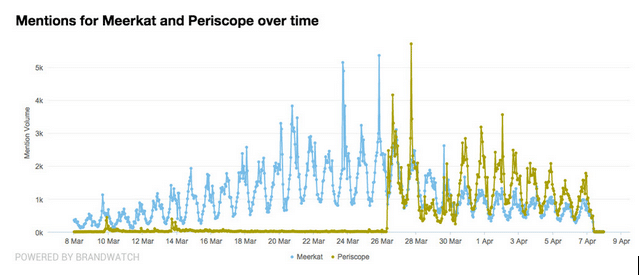Has The World Gone Live Stream Video Crazy?
Video live streaming apps like Meerkat, Periscope and You Now have started to dominate smartphone homescreens and are consequently capturing the attention of the massive mobile video market.
In the last couple of months there’s been an ever-growing buzz around these new live format video apps.
A world of raw, unedited, uncontrollable video streaming beamed across the digital airways may not have been so desirable not so long ago, but there’s something about the now, the spirit of the times, which has opened up this whole new world.
But which app has got the edge? Meerkat or Periscope?
Well, before we look at the data, let’s take a look at the background of these two rivals.
Background
The boom started with Meerkat back earlier this year. Its proposition was simple: Point your camera at a subject and hit stream. Whatever you were looking at would then be broadcast to whoever was watching.
It was not a new concept – as anyone who has ever used UStream or any other streaming product would tell you – but what made Meerkat stand out from the crowd was the social integration. In Meerkat’s case, Twitter.
At conception, every action and following interaction took place on both Meerkat and Twitter at the exact same time, helping the discovery of content streams and their viral spread.
Meerkat shot to prominence earlier this year at SXSW, just like Twitter managed back in 2007, and content was soon flooding the platform during the event, putting the infrastructure under real stress.
Among the many broadcasts beamed during the event there was one common theme: Meerkat vs Periscope. Even after the event was over, the conversation continued. Nearly every time I checked out Meerkat (many times a day) there was someone discussing the two apps.
But how do they compare? Well, Periscope was purchased by Twitter while still in closed beta for a reported £100M price tag in early March. While the concept was very similar to Meerkat, Twitter’s backing gave Periscope a huge amount of publicity and fanfare, despite being second to market.
Twitter launched officially in the UK the day after their London #TwitterStories event in late March, and I was fortunate enough to attend to see a demo of the unreleased platform. While it certainly looked shinier from the offset, I did not see anything to give it the edge over its rival. After all, in technology land, first to market is a big advantage. If you’ve got something, you’ve GOT something. You can always polish it later.
The live-steam battle was officially on! But how do the two compare? Well, let’s take a look at the data.
Social mentions
Looking at data from Brandwatch, which tracks all social mentions, a pattern becomes very clear.
Firstly, you see the growth Meerkat had initially, but then the introduction of Periscope saw a large drop in Meerkat mentions. Unsurprisingly, Twitter went big on the marketing, as you might imagine, and the fruits of this are this are pretty clear to see.
When you look at some data firstly by day, there’s a dominant introduction of Periscope data towards the end of March.

If we look at the data up to the present day on a daily basis, the disparity is stark. Despite a sudden drop at the end of May, the numbers have been significantly higher for Periscope. Meanwhile, Meerkat mentions have been slowly declining.

With any big new app battle, there are always swathes of users who sign up just to find out what all the fuss is about.
User base
But it’s sticking power that defines whether apps sink or swim. No solid user base, then your app is destined for iPhone screen 2. Which is about as fruitful as being on page 2 of Google.

But it’s not just all about the mentions. Users are what makes the app world go around, after all.
Utilising AppAnnie data, it’s clear to see that in the chart rankings Meerkat is nowhere to be seen, while Periscope sits currently at #159 in iOS App Store and #29 in Google Playstore. While it’s not touching the likes of Vine and Snapchat in the app ranking world, Meerkat doesn’t feature in the top 500 listing of either app store.
Unfortunately, it’s still too early to expect either platform to share active user numbers. It’s possible that Meerkat onboarded enough users in the time it took Periscope to enter the market officially with Twitter that the AppAnnie stats might not be as damning for Meerkat as they might first appear.
Marketing Future
User numbers and mentions aside, the real question for marketers is how do brands fit into the picture?
Is this just one step too far for brands as they struggle to keep pace with the influx of new formats appearing in the video landscape?
Whether it’s 6, 8, 15, 30 second or long-form content, optimizing for a full content stack takes time, consideration and a well-constructed distribution plan. Live takes away the safety net brands will be accustomed to.
There’s no bumpers in live-stream video land. Whilst it’s easy to dabble, doing an office tour or shooting some footage at an event, long-term success is quite hard to imagine in its current configuration.
While live-streaming could easily become part of the marketing mix, it’s very unlikely to be front and centre anytime soon.
Will this phase wear off? Will live-stream be the ello of the video world? Who knows. As always, time will tell. The video world can be a funny place. Who would have thought a 6-second looping video format would ever be so fruitful a few years ago.
[pardot-form id=”4616″ title=”Trending Content Sign Up”]
